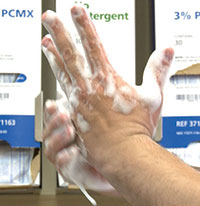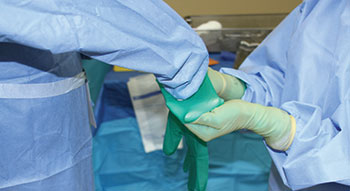Proper Hand Hygiene, Gowning, & Gloving Significantly Reduces Infection Transmission


We've all learned from a young age that hand washing keeps germs at bay, but when it comes to surgical patient care and safety, simple handwashing just isn't enough.
The Agency for Healthcare Research and Quality estimates that surgical site infections (SSIs) occur in 2% to 4% of all patients undergoing inpatient surgical procedures. SSIs can have a devastating effect on a patient's morbidity, including the potential for an extended hospital stay, delayed wound healing, pain and discomfort and other complications. Taking proper steps in the perioperative environment to mitigate the transmission of microorganisms keeps patients safe and reduces the risk of spreading contaminants to perioperative staff members as well. Brian Dawson, RN, MSN, CNOR, CSSM, System VP for Perioperative Services at Common Spirit Health reinforces these patient safety practices through a combination of training tactics. Dawson highlights the usefulness of the CineMed AORN video-based education program to introduce AORN's recommended practices and maintain success in annual competency audits. He also emphasizes the benefit of one-on-one clinical education and demonstration as well as individual practice and return demonstration.
The perioperative environment presents many risks for exposure to blood and other body fluids which can contaminate personal protective equipment. Handling surgical specimens, draining urinary catheter bags, colostomy bags, and other drains, handling used sponges, and inserting or assessing an invasive device are just a few examples. AORN has established protocols for proper hand hygiene based on the level required relative to patient interaction. For instance, there are some cases where simply performing an alcohol-based hand rub is sufficient and others where soap and water are necessary to remove organic material. Perioperative team members preparing for operative and invasive procedures must perform surgical hand antisepsis, which is the primary line of defense to protect the patient from transmission of pathogens.
Gowning and Gloving Practices
Maintaining sterility in the perioperative environment requires perioperative team members to perform surgical hand antisepsis before donning sterile gowns and gloves. Here too, AORN has set forth recommended practice guidelines for appropriately donning surgical attire so as not to contaminate the instrument table, as well as proper removal tactics to reduce the risk of shedding organisms into the environment. It is recommended that perioperative team members wear two pairs of surgical gloves, one over the other, in cases where the potential for contact with blood, body fluids and other infectious material is present.

Compliance is Imperative to Reducing Infection Risk
Reducing the risk of surgical site infections and cross-contamination between caregivers and patients requires vigilance and best practices by all perioperative team members. In his prior roles in the OR setting, Brian Dawson included perioperative educators, clinical specialists, and infection preventionists in evaluating hand hygiene products and running trials to assess effectiveness of the products. The best path to success is to create buy-in from the team by way of including them in the evaluation of hand hygiene products and quality assurance of product effectiveness, as well as consistently delivering the message of maintaining a safe perioperative setting for both patients and team members. Dawson's team ensures staff compliance by conducting individual audits using a survey tool created by perioperative clinical specialists and infection preventionists. His advice to other perioperative educators - "ensure staff are educated, monitor their practice, reeducate when needed, and champion the staff when you've shown progress."
To learn more about proper hand hygiene and protocols for gown and glove donning and doffing, and more, check out the Hand Hygiene, Scrubbing, Gowning, and Gloving perioperative education module, including the video and study guide, part of the CineMed AORN Online Perioperative Education program available at https://cine-med.com/aornonline.

